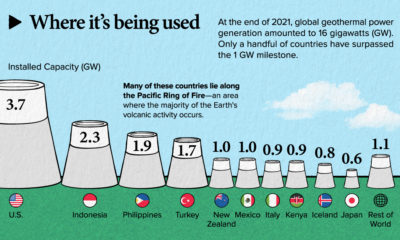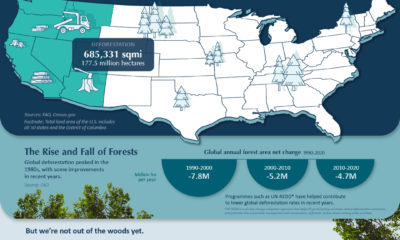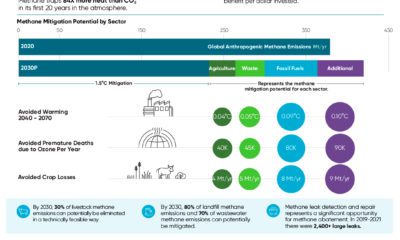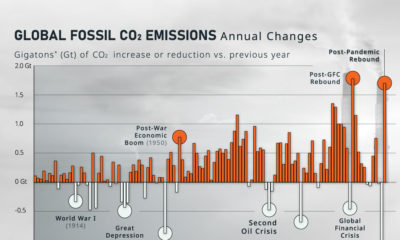Given their size and influence, many of these companies are taking climate action quite seriously. For example, 30% of the group have either achieved a climate goal or are publicly committed to doing so by 2030—a significant increase from just 6% in 2016. In this infographic, we’ve used data from Natural Capital Partners to provide a holistic view of when Fortune Global 500 companies plan to meet their stated climate goals.
Climate Action Takes Several Forms
When taking climate action, businesses have a variety of targets they can pursue. Three of the most common ones include carbon neutrality, RE100, and science based targets (SBT). After choosing a target, businesses can also set a date for when they intend to achieve it. As the above graphic shows, many companies are targeting 2030, a year that is frequently touted as a deadline for meeting the goals of the Paris Agreement. A fourth target known as “net zero emissions” is also used, though its exact definition tends to vary. For the purposes of this infographic, we’ve considered a commitment to net zero emissions to be the same as achieving carbon neutrality.
A Complete Overview
The following table summarizes the climate actions of Fortune Global 500 companies. Firms that made commitments without a target date have been noted in the table with a “C”.
Note: This data was aggregated from various sources throughout 2020, and as a result, may not include the latest climate commitments announced by companies within the Fortune Global 500.
As of October 2020, 163 companies from the Fortune Global 500 have publicly committed to achieving at least one of these climate targets. That represents 32.6% of the total group.
The most common target is carbon neutrality, which has 91 companies on board. In second place is science based targets (SBT), which has 74 companies committed—of those, 16 have not declared a target date. RE100 was the least common, with 56 companies committed. Because some companies are committed to multiple targets, these figures add to more than 163.
Climate Action is on the Rise
Private-sector awareness around climate change and other sustainability issues has gained strong momentum in recent years. Since 2011, the number of S&P 500 companies publishing sustainability reports increased from 20% in 2011, to 90% in 2019. This was likely due to investor demand and a broader acceptance of environmental, social, and governance (ESG) criteria. Governments around the world are also taking a more proactive approach to climate action. The Biden administration, for example, seeks to make a $2 trillion investment to help a variety of U.S. industries become more sustainable. America’s goal of reaching net-zero emissions by 2050 is shared with a handful of other advanced economies, including Japan and the EU. The UK has taken these pledges one step further, becoming the first G7 country to pass a law that requires itself to bring emissions to net zero by 2050. on Over recent decades, farmers have been able to more than double their production of crops thanks to fertilizers and the vital nutrients they contain. When crops are harvested, the essential nutrients are taken away with them to the dining table, resulting in the depletion of these nutrients in the soil. To replenish these nutrients, fertilizers are needed, and the cycle continues. The above infographic by Brazil Potash shows the role that each macronutrient plays in growing healthy, high-yielding crops.
Food for Growth
Nitrogen, phosphorus, and potassium (NPK) are three primary macronutrients that are the building blocks of the global fertilizer industry. Each plays a key role in plant nutrition and promoting crop growth with higher yields. Let’s take a look at how each macronutrient affects plant growth. If crops lack NPK macronutrients, they become vulnerable to various stresses caused by weather conditions, pests, and diseases. Therefore, it is crucial to maintain a balance of all three macronutrients for the production of healthy, high-yielding crops.
The Importance of Fertilizers
Humans identified the importance of using fertilizers, such as manure, to nourish crops dating back to nearly 6,000 to 2,400 BC. As agriculture became more intensive and large-scale, farmers began to experiment with different types of fertilizers. Today advanced chemical fertilizers are used across the globe to enhance global crop production. There are a myriad of factors that affect soil type, and so the farmable land must have a healthy balance of all three macronutrients to support high-yielding, healthy crops. Consequently, arable land around the world varies in the amount and type of fertilizer it needs. Fertilizers play an integral role in strengthening food security, and a supply of locally available fertilizer is needed in supporting global food systems in an ever-growing world. Brazil is one of the largest exporters of agricultural goods in the world. However, the country is vulnerable as it relies on importing more than 95% of its potash to support crop growth. Brazil Potash is developing a new potash project in Brazil to ensure a stable domestic source of this nutrient-rich fertilizer critical for global food security. Click here to learn more about fertilizer and food production in Brazil.































